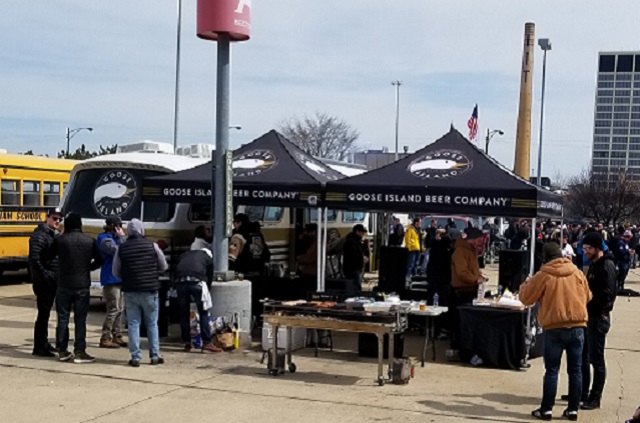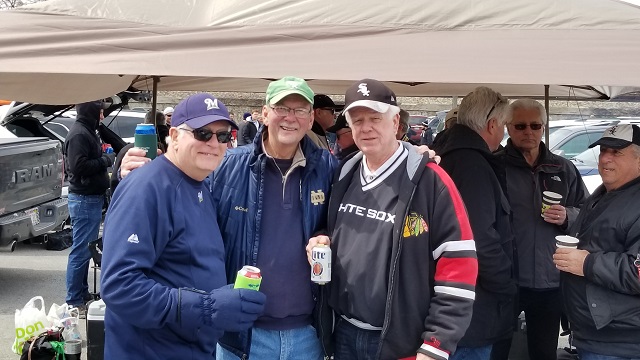“It’s easy to find us,” says John Weyer about his White Sox tailgating crew that’s been ushering in the baseball season at their Guaranteed Rate Field lot for about 25 years. “If you don’t know where we are, we say meet at the car with White Sox flag with the shamrock…and the ‘WIN UGLY’ license plate.”
The intriguing “Win Ugly” moniker for the Chicago team came about in their 1983 season. Around the time of the All Star Game that year, the Sox were blazing through a winning streak. Texas Rangers manager Doug Rader remarked that the team wasn’t really playing well despite their victories. “They’re winning ugly,” he said.
And like all hard-core Chicago sports fanatics, White Sox fans grabbed hold of the demeaning critique. They turned the phrase into a rallying cry that led their team to win the American League West championship that year, marking their first postseason action since the 1959 World Series.
The nickname—with a little leeway on the spelling—now proudly adorns the license plate of Weyer’s tailgating buddy, Mick Hyland, who just attended his 50th home opener last year. It’s the closest thing the tailgating crew has to an official name, Weyer says, who grew up in a tailgating family. For generations, they’ve been rabid tailgaters at Notre Dame football games. Even a few Bears games. ”I’m more of a visitor at Bears games because my Saturdays are committed, so going to a game on Sunday too is a tough challenge,” he admits.
Many of the same people from the football tailgates spill over into the baseball gatherings, which start about five hours before the first pitch. “We’re always waiting for the gates to open to the lot,” says Weyer.

The Opening Day that Wasn’t
“2017 was the most memorable season opener, because opening day didn’t happen,” laughs Weyer.
That April baseball day started normally. The lots were full despite the rain, everyone tailgated and then the crowd surged into the stadium per usual. The players rode around the warning track in red Mustang convertibles waving to the roaring crowd, and members of REO Speedwagon sang the national anthem. The ceremonial first pitch even got thrown.
“It was then that they called the game due to weather,” Weyer says with shock. The rain had been sporadic and persistent all day with no break in sight, and the timing of the outright cancellation of game seemed liked sacrilege. “They did all the player intros, and then they didn’t play the game. There was a lot of disappointment about that. But we still were able to tailgate, so it was still opening day.”
The game did get played against the Detroit Tigers the following afternoon. The White Sox lost 6–3.
After the game was called, some of Weyer’s gang ended their game-less opening day celebration at various nearby establishments. A few stuck around. “They were shutting down the lots,” he says. Then adds that usually that ritual doesn’t stop the Win Ugly group. “We’re briefly allowed to tailgate after a game. But after a while, security comes around and kindly asks you to leave—at least the first time,” he chuckles. “They get a little testy after about the fifth time.”
North versus South
Unlike their despised co-city rivals, the Cubs, the White Sox allow tailgating in all seven lots around their Guaranteed Rate Field—called U.S. Cellular Field until last season. “I’ve been to the Cubs’ Wrigley Field,” Weyer says. “They don’t even have parking lots close by where you can tailgate. With the Cubs, it’s much more about going to bars before the game.”
Surprisingly for such a vast metropolis, the two rival stadiums sit only 7 miles apart. “Wrigley’s only one ‘L’ train ride away,” Weyer says with a twinge of disgust in his voice.
But the divide between the fans is immense. Loyalty to one or the other team rarely has to do with performance or even choice. “A lot of times, it’s determined by geography and family,” explains Weyer. “My family is all from the south side of Chicago originally and that sort of carries over to the White Sox.” The north side of Chicago gravitates toward the Cubs. No matter where the family members move, though, their baseball loyalties remain the same.
So in Chicago when the White Sox play the Cubs, it signals the second must-go tailgate for Weyer’s crew. “There’s three or four games where the big group shows up—the season opener, the Cubs game, and…it’s been a while…but playoff games,” he says. The White Sox last reached postseason status in 2008 after defeating the Twins in a one-game play-off to become the American League (AL) Central champions. They went on to lose to the Tampa Bay Rays in the resulting AL Division Series.
For these big draw games, Weyer’s Win Ugly tailgate forms a line of three or four cars from their core families. But that 10 to 15 people quickly doubles as friends and passersby arrive. “There’s plenty of music,” he says, provided by a boom box playing their go-to songs like a round of the old White Sox favorite “Hey Hey Hey, Goodbye.” That tradition started in ‘77 when their “Hit Men” of power hitters with their home-run prowess would drive a pitcher back to the dugout and the fans would sing him off the mound with that tune. “It’s a national thing now,” touts Weyer, “but it kinda started with the White Sox.”

Warm Ups
Besides belting out the standards, grills will be heard sizzling with bratwursts and other sausages throughout the lot. People play cornhole—“around here we usually call it bags,” he says—and set up chairs to casually enjoy the atmosphere before they stroll into the stadium.
“Some guys at our tailgate bring sub sandwiches. We keep it simple,” describes Weyer. “And there’s a variety of coolers. One’s got light beer; one’s got regular beer; and if you look hard enough, you might find a water.” If winter still lingers, liquid warming elixirs emerge instead, like brandy and Irish whiskey.
But Weyer claims the season opener itself warms up Chicago baseball fans. “Everyone is optimistic about the upcoming year at opening day. It’s a sign that it’s going to get better. And the first official sign that winter is over,” he says, though the weather doesn’t always agree with the calendar. Halfway through the 2018 opening day game, it started snowing.
Cased Meats
Like its windy, unpredictable spring weather, Chicago is also rightly renowned for its cased meats. Which is why, no matter what’s served at his own tailgate, Weyer says two things must be eaten inside the stadium on opening day. “Polish sausage with onions and mustard, and then an Italian sausage or a hot dog. Not a Chicago dog, though, not after I’ve had a sausage. That’s too much of a good thing.”
That’s because the traditional Chicago dog is part meat and a lot of the backyard garden. Atop the steamed all-beef hot dog sits a glory of what should be conflicting condiments—sweet pickle relish, a dill pickle spear, pickled sport peppers (tiny hot peppers), yellow mustard, tomato wedges, chopped onions, and, bizarrely, celery salt. “The most important thing is that it does not have ketchup,” stresses Weyer.
Baseball versus Football Tailgates
Not everyone in the White Sox lots tailgate. “Some just park their cars and go in,” Weyer says, leaving more room and a calmer atmosphere, except on opening day.
On that annual Chicago pilgrimage, the energy and the hope runs high. Numbers in the lot swell to capacity and fans linger to talk about the potential of the new season and relive old ones. And they come decked out in their lucky whatever. “People are wearing brand new Sox jackets and others are wearing a 30-year-old Sox jacket that they break out for every opening day,” laughs Weyer.
For regular season games, the lot takes on a more nonchalant, laid-back vibe. “Some people tailgate by just sitting on their bumper having a beer, and others have chili and grills going and chairs out,” describes Weyer. It’s not like football, he says, where nearly every car in the lot at every game hosts tailgaters.
“Baseball tailgating has a different feel,” states Weyer. With only seven or eight home games, every football game feels intense and important. “Baseball has so many games, it doesn’t maintain that level of excitement, unless it’s divisions or going to the playoffs.”
The baseball tailgate vibe is about seeing friendly faces, having a good time and hopefully seeing a win. “The tailgates are pretty simple, too, mainly because you’re not spending all day there, like with football,” he says.
With 81 home games, fans can also be choosier about attendance. “Football people tailgate in any weather, but there’s so many more games in baseball that you have the luxury of waiting for better weather before trekking to the field,” explains Weyer.
Marathon Tailgate
But weather doesn’t always matter. Sometimes a Sox fan has to tailgate. In 2003, Weyer’s crew was tailgating in the rain. Not unheard of in a Chicago summer. “But we were in the rain for quite a few hours,” recalls Weyer, who’d brought rain gear. Others weren’t so seasoned and the lot was filled with trash-bag covered people.
The game was supposed to start at 1 p.m. But officials kept delaying it, so the Win Ugly group kept tailgating. “We’d been there since 10 in the morning,” he says. “It didn’t start until 7 p.m.” They kept betting on when the game would start, and the entire lot had dwindled dramatically by the time officials called a starting time that evening. “Anyone smarter than me was not staying out there in the rain waiting for a game.”
But Weyer says he has to tailgate. “I don’t know what else to do with myself. I go into withdrawal if I don’t get a tailgate in every month or so.” His family is just as hooked. Even the three kids, who run in age from 16 to 23. When asked what makes his teenage to college-age kids still join the family tailgates, he says, “They don’t know any different. They’re genetically disposed from their great-grandparents’ tailgates at Notre Dame.”



